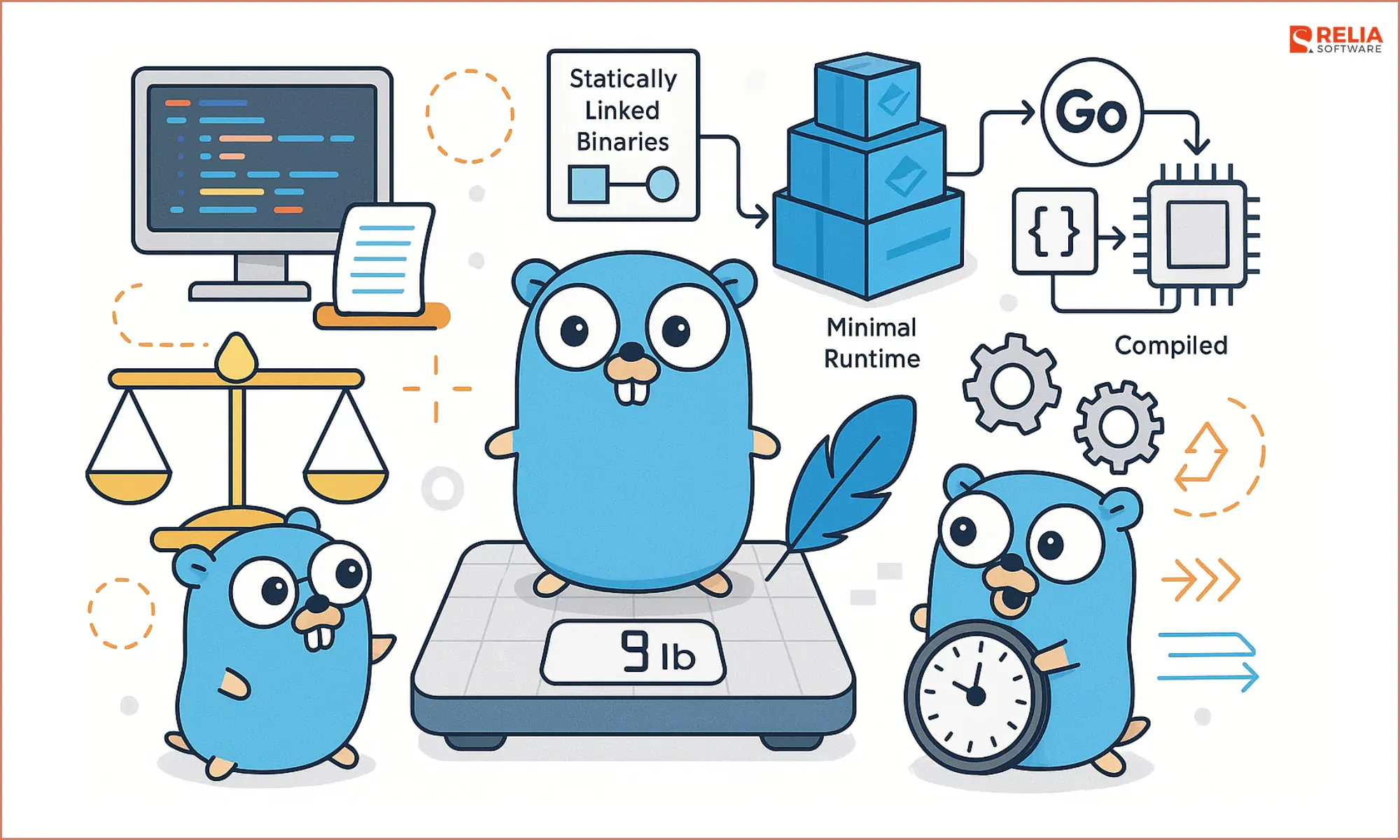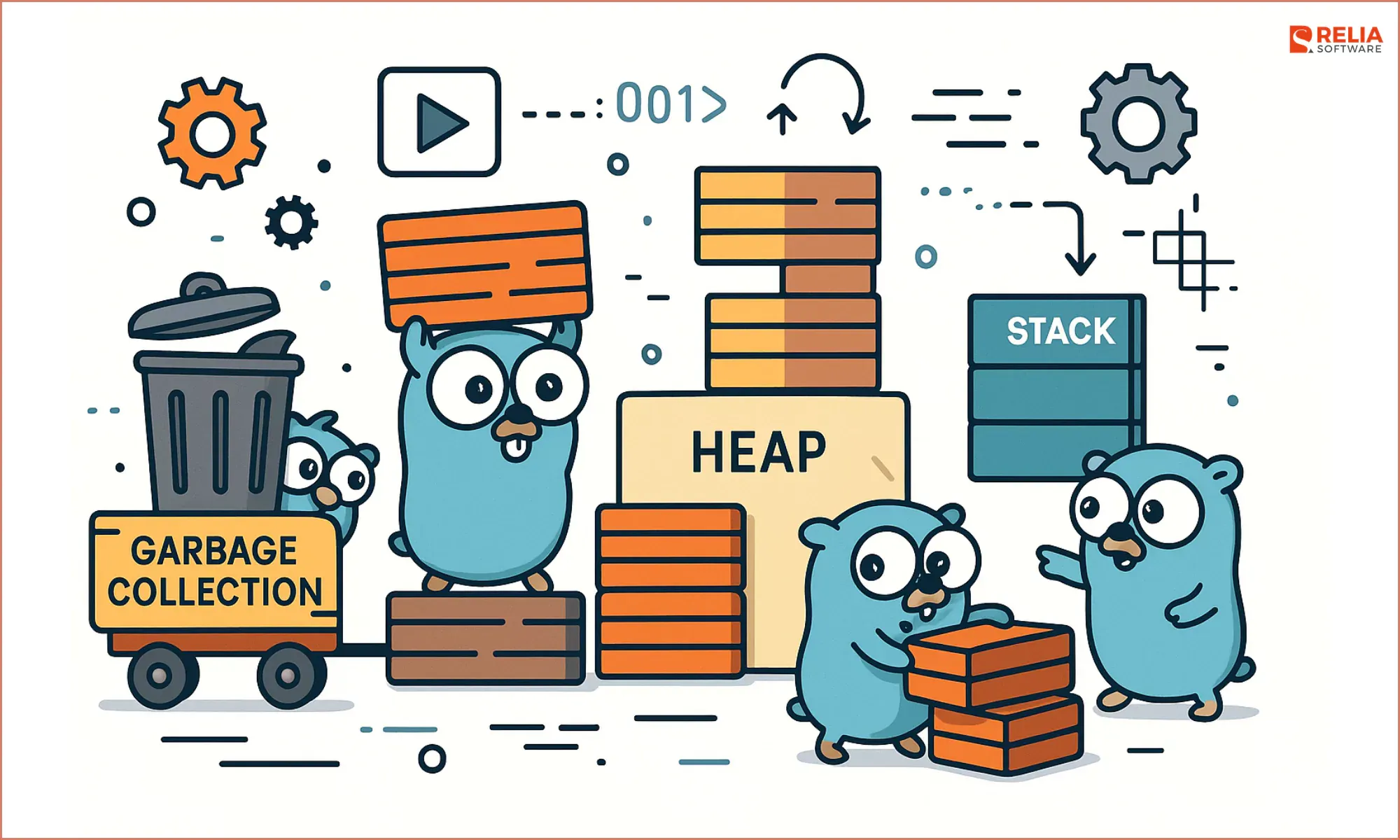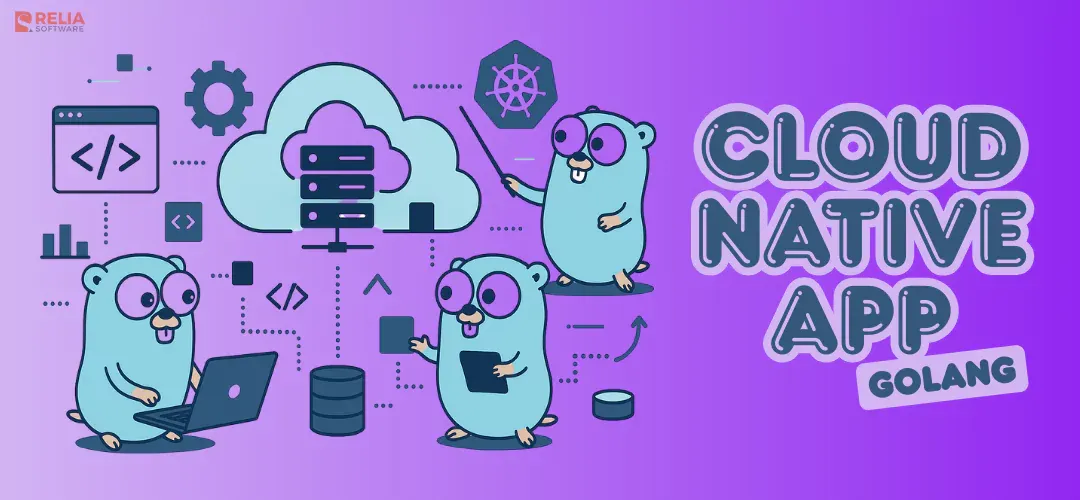Success with cloud-native apps demands the correct tools and programming language. Go (Golang) is in top cloud development languages due to its speed, simplicity, and concurrency support. Well, this post will explain detailedly why Go is special and how it helps developers build quick, scalable, and dependable cloud-native apps.
>> Read more:
- Tips For Hiring The Best Golang Developers
- Best Practices For Dependency Inversion in Golang
- The 10 Best IDEs for Golang Web Development
Lightweight Nature
Golang's lightweight design fits perfectly for development of cloud-native apps. This results from the intended language design.
- Simple and Minimalistic Syntax: Go's syntax is intentionally designed to be clean, concise, and straightforward. The language avoids unnecessary complexity, reducing the cognitive load on developers. This simplicity translates to code that is easy to read, write, and maintain, contributing to a smaller overall codebase.
- Small Standard Library: Go's standard library is minimalistic and focused on essential functionalities. This approach prevents unnecessary bloat in applications that only require specific features. Developers can import additional packages as needed, keeping the application's memory footprint lean.
- Statically Linked Binaries: Go produces statically linked binaries, which means that all the necessary dependencies are compiled into the executable itself. This eliminates the need for additional dynamic libraries during runtime, resulting in self-contained executables that are lightweight and easier to distribute.
- Minimal Runtime Overhead: Go's runtime overhead is kept to a minimum. The runtime provides necessary features like garbage collection, goroutine management, and reflection, but it doesn't introduce significant overhead. This ensures that applications written in Go have a smaller runtime footprint.
- Compiled Language: Go is a compiled language, which means that the code is compiled into machine code before execution. This compilation step allows the compiler to optimize the code for performance and size. The resulting compiled binaries are typically smaller than those produced by interpreted or Just-In-Time (JIT) compiled languages.
- No Virtual Machine Overhead: Unlike languages that rely on virtual machines or interpreters, Go's direct compilation to machine code eliminates the overhead associated with running code in a virtual environment. This results in faster startup times and reduced memory consumption.
- Efficient Concurrency Model: Go's lightweight concurrency model, based on goroutines and channels, enables the creation of thousands of concurrent execution units without overwhelming system resources. This allows developers to build highly parallel and responsive applications efficiently.
- Reduced Boilerplate Code: Go's focus on simplicity and minimalism leads to less boilerplate code. Features like type inference, concise variable declaration, and built-in error handling streamline code, resulting in smaller codebases.

>> Read more: Type Conversion in Golang: How To Convert Data Types in Go?
Built-in Concurrency
Go's built-in concurrency features are one of its standout characteristics, making it a powerful choice for developing applications that require efficient management of multiple concurrent tasks.
- Goroutines: Goroutines are lightweight, independently scheduled threads of execution within a Go program. They provide a simple and efficient way to achieve concurrency. Goroutines are much lighter in memory usage and overhead compared to traditional operating system threads. They are managed by Go's runtime scheduler, which efficiently multiplexes them onto a smaller number of operating system threads.
- Concurrency without Overhead: Creating a goroutine is as simple as prefixing a function call with the
gokeyword. This spawns a new goroutine that runs concurrently alongside the main program or other goroutines. Goroutines are managed by the Go runtime, and their creation and teardown incur minimal overhead, making it feasible to create thousands of them. - Cooperative Multitasking: Goroutines are cooperatively scheduled, meaning they yield control to the scheduler during certain points in their execution (e.g., when performing I/O operations). This cooperative nature ensures that goroutines don't block each other excessively, leading to more efficient use of system resources.
- Channels: Channels are the communication mechanism that allows different goroutines to exchange data and synchronize their execution. Channels provide a safe way to share data between goroutines without the need for explicit locks. They encourage the sharing of memory by communicating, not by sharing, which is a fundamental Go principle.
- Buffered and Unbuffered Channels: Channels can be buffered or unbuffered. Unbuffered channels ensure synchronous communication—sender and receiver synchronize at every data exchange. Buffered channels, on the other hand, allow a limited number of values to be stored before blocking, enabling asynchronous communication and reducing contention.
- Select Statement: The
selectstatement is used to handle multiple channel communications within a singleselectblock. It allows a goroutine to wait on multiple channels simultaneously and proceed with the case that becomes ready first. This construct is valuable for managing complex concurrent scenarios. - Data Race Detection: Go includes built-in support for detecting and preventing data races—a type of concurrency bug where multiple goroutines access shared variables concurrently without proper synchronization. The Go runtime's race detector can help identify potential data race conditions during testing.
- Concurrency Patterns: Go's concurrency primitives enable the creation of powerful concurrency patterns. Patterns like fan-out/fan-in (parallelizing and aggregating work), worker pools (limiting concurrent processing), and pipeline processing (chaining stages of data processing) can be easily implemented with goroutines and channels.
- Parallelism and Concurrency: Go's concurrency primitives enable developers to build concurrent programs. Parallelism—the simultaneous execution of tasks on multiple processors—can be achieved by running multiple goroutines on different CPU cores, leveraging the multicore processors of modern machines.
- Simplicity and Readability: Go's concurrency model is designed to be intuitive and readable, reducing the likelihood of errors associated with traditional thread-based programming. This encourages developers to embrace concurrency without the fear of introducing complex synchronization issues.
Efficient Memory Management
Efficient memory management is a critical aspect of programming, especially in cloud-native and resource-intensive applications. Go incorporates a memory management model that aims to balance performance, resource utilization, and developer convenience. Here's an in-depth look at how Go achieves efficient memory management:
- Garbage Collection (GC): Go features an automatic garbage collection system that manages memory by reclaiming memory that is no longer in use. This alleviates the need for developers to manually allocate and deallocate memory, reducing the likelihood of Golang memory leaks and errors.
- Generational Garbage Collector: Go's garbage collector employs a generational garbage collection strategy. It divides objects into different generations based on their age, with younger objects being collected more frequently. This approach optimizes collection times and minimizes the impact on application performance.
- Concurrent Garbage Collection: Go's garbage collector operates concurrently with the application code. This means that garbage collection tasks are carried out in parallel with the execution of goroutines, reducing pause times and improving application responsiveness.
- Low Latency: Concurrent garbage collection in Go aims to keep pause times—moments when application execution is temporarily halted for garbage collection—low and predictable. This is particularly beneficial for applications requiring real-time responsiveness.
- Heap Management: Go's runtime manages the heap, where dynamically allocated objects reside. The runtime controls memory allocation, deallocation, and garbage collection cycles for the heap. Developers can focus on writing code without manually managing heap operations.
- Small Stack Frames: Go uses fixed-size stack frames, allowing for efficient memory allocation and deallocation. This contributes to faster function calls and lower memory consumption, particularly important in scenarios with many concurrent goroutines.
- Escape Analysis: Go's compiler performs escape analysis to determine whether objects created within a function can be allocated on the stack instead of the heap. Stack allocation reduces the overhead of memory management and improves performance.
- Deferred Memory Allocation: Go follows a "lazy" or deferred memory allocation approach. This means that memory is allocated for a variable only when it is first used, allowing the runtime to optimize memory utilization based on actual program behavior.
- Interface Optimization: Go's interface values are implemented using a small header that points to a concrete value. This reduces the memory overhead associated with storing interfaces and contributes to more efficient memory usage.
- Efficient Concurrency Model: Go's lightweight goroutines and channels contribute to efficient memory usage. Goroutines have smaller stack sizes compared to traditional threads, enabling the creation of numerous concurrent tasks without consuming excessive memory.
- Memory Layout: Go's memory layout is designed to be compact and cache-friendly. This helps reduce memory fragmentation and improves data access times, contributing to overall application efficiency.

Speed and Performance
Here's a simplified performance comparison table between Go and some other popular programming languages.
| Language | Concurrency | Compilation Speed | Memory Manage-ment | Networking Perform-ance | Benchmark Results | Micro-services Support |
|---|---|---|---|---|---|---|
| Go | Goroutines/ Channels | Fast | Garbage Collection | Optimized | Competitive | Excellent |
| Java | Threads/ Executors | Slower | Garbage Collection | Efficient | Competitive | Good |
| C++ | Threads/ Async | Moderate | Manual Memory Management | Efficient | Competitive | Good |
| Python | Threads/ Asyncio | Slower | Automatic Memory Management | Moderate | Moderate | Fair |
| Rust | Async/ Await | Moderate | Memory Safety | Efficient | Competitive | Good |
| Node.js | Event Loop/Async | Fast | Garbage Collection | Efficient | Moderate | Good |
It's important to note that the choice of programming language depends on the specific requirements of the application, the developer team's expertise, and other considerations beyond pure performance. While Go offers a strong balance between speed, performance, and developer productivity, the right choice varies based on the specific needs of the cloud-native application.

Compatibility with Containers and Orchestration
Go is highly compatible with containers and orchestration platforms, making it an excellent choice for developing cloud-native applications that leverage containerization and deployment in distributed environments. Here's an in-depth look at Go's compatibility with containers and orchestration:
- Statically Linked Binaries: Go compiles to statically linked binaries, which means that an application's executable includes all its dependencies. This reduces the need for external libraries and ensures that the application runs consistently across different environments. Statically linked binaries are ideal for containerization, as they eliminate version conflicts and compatibility issues.
- Lightweight Binaries: Go's compiled binaries are relatively small in size compared to applications written in some other languages. This attribute is advantageous for containerization, as it results in smaller container images. Smaller images lead to faster deployment, less storage consumption, and improved resource utilization.
- Simplified Dependency Management: Go's built-in package management tool, "go get," makes it easy to manage dependencies. The Go tooling ensures that dependencies are versioned and isolated, reducing the chances of conflicts when building and deploying containerized applications.
- Efficient Resource Utilization: Go's efficient memory management and concurrency model are well-suited for containerized applications. Applications written in Go can make better use of the resources allocated to containers, maximizing performance and minimizing overhead.
- Integration with Container Runtimes: Go's compatibility with container runtimes like Docker is seamless. Applications written in Go can be packaged into Docker containers with ease, providing a consistent way to deploy and manage applications across different environments.
- Kubernetes Compatibility: Go is a favored language within the Kubernetes community due to its compatibility and efficiency. Kubernetes, a popular container orchestration platform, works seamlessly with Go applications. Go's lightweight nature and concurrency model align well with the dynamic nature of Kubernetes clusters.
- Kubernetes Native Libraries: Go has native libraries that simplify interactions with Kubernetes. The "client-go" library allows developers to interact with the Kubernetes API and manage resources programmatically. This facilitates the development of custom controllers, operators, and automation tools for Kubernetes.
- Service Discovery and Load Balancing: Go applications can utilize service discovery and load balancing features offered by container orchestration platforms like Kubernetes. These features enable applications to dynamically discover and communicate with other services within the cluster.
- Scalability and Elasticity: Go's built-in concurrency model and lightweight goroutines facilitate the development of applications that can scale horizontally by adding more instances. This aligns well with the principles of containerization and orchestration, where applications can be scaled up or down based on demand.
- Continuous Integration and Continuous Deployment (CI/CD): Go's fast compilation times and small binaries contribute to efficient CI/CD pipelines. Developers can quickly build and deploy container images, enabling rapid iteration and frequent releases.
Robust Standard Library
Golang boasts a robust and comprehensive standard library that provides developers with a wide range of tools and functionalities to simplify common programming tasks. This standard library contributes to Go's efficiency, productivity, and suitability for cloud-native development. Here's an in-depth look at Go's robust standard library:
Networking:
- net/http: Offers an HTTP client and server implementation with support for HTTP/1.1, HTTP/2, and WebSocket protocols.
- net: Provides networking primitives for working with sockets, IP addresses, and DNS resolution.
Concurrency:
- sync: Offers synchronization primitives like mutexes and condition variables for safe concurrent programming.
- context: Facilitates cancellation and timeout management across concurrent tasks.
I/O and File Handling:
- io: Defines interfaces for I/O operations, making it easy to work with different I/O sources and sinks.
- bufio: Provides buffered I/O for efficient reading and writing of data.
Data Serialization and Encoding:
- encoding/json: Enables JSON serialization and deserialization.
- encoding/xml: Supports XML encoding and decoding.
- encoding/gob: Facilitates binary serialization for Go types.
Data Manipulation and Parsing:
- strings: Offers utilities for string manipulation and searching.
- strconv: Provides functions for converting strings to basic types and vice versa.
- regexp: Allows regular expression pattern matching and substitution.
Time and Date Handling:
- time: Facilitates time and date manipulation, formatting, and parsing.
- time/tzdata: Provides time zone information.
Encryption and Hashing:
- crypto: Offers cryptographic primitives for hash functions, encryption, decryption, and more.
- crypto/tls: Implements secure communication over TLS/SSL.
Data Structures and Collections:
- container: Provides useful data structures like heap, ring, and list.
- heap: Offers heap implementation for use in priority queues.
Command-Line Tools and Flags:
- flag: Supports parsing command-line flags and arguments.
- os: Provides functionalities for interacting with the operating system, including file manipulation and environment variables.
Internationalization and Localization:
- i18n: Facilitates internationalization and localization of applications.
Reflection:
- reflect: Enables introspection of Go types, allowing runtime inspection of objects.
Testing and Benchmarking:
- testing: Offers a testing framework for writing unit tests and benchmarks.
- testing/quick: Provides utilities for property-based testing.
Regular Expressions:
- regexp: Supports regular expression pattern matching and replacement.
Error Handling:
- errors: Provides the
errorinterface for consistent error handling.
Miscellaneous Utilities:
- fmt: Facilitates formatted I/O and string formatting.
- log: Offers a basic logging package.
- sort: Provides sorting algorithms for slices.
- path/filepath: Enables manipulation of file paths.
- math: Offers mathematical functions.
Unicode and Character Handling:
- unicode: Provides utilities for working with Unicode characters and code points.
System-Level Interaction:
- syscall: Allows direct interaction with the operating system's system calls.
Dependency Management:
- go mod: Provides tools for managing dependencies and versioning in Go modules.
In summary, Go's robust standard library covers a wide range of functionalities required for various programming tasks, from networking and I/O to concurrency, encryption, testing, and more. This comprehensive library accelerates development by providing consistent and reliable solutions to common challenges, making Go a powerful language for building cloud-native applications efficiently.
Community and Tooling
Community
- Vibrant Community: The Go (Golang) community is known for its inclusivity, collaboration, and open-source spirit. Developers from diverse backgrounds contribute to discussions, share knowledge, and provide support.
- Open Development: Go's open-source nature encourages community participation. The development process, codebase, and documentation are accessible to all.
- Resources and Communication: Official resources, mailing lists, forums, and social media platforms facilitate communication, knowledge sharing, and troubleshooting.
- Knowledge Exchange: Online platforms like Reddit and Stack Overflow offer spaces for developers to ask questions, share insights, and stay updated on Go-related news.
Tooling
- Go Command: The central tool for Go development, it handles tasks like building, testing, and running Go programs.
- Go Modules: The official dependency management system simplifies versioning, dependency resolution, and module management.
- Formatting and Imports: Tools like gofmt and goimports ensure consistent code formatting and manage imports, maintaining readability and organization.
- Testing and Profiling: The testing package supports unit testing and benchmarking, while tools like pprof and trace aid in profiling and performance analysis.
- Documentation Generation: godoc generates user-friendly documentation from code comments, facilitating understanding and usability.
Ease of Deployment
- Statically Compiled Binaries: Go's compiled binaries include all dependencies, leading to consistent behavior across environments and reducing dependency-related issues.
- Minimal Dependencies: Go binaries have minimal runtime dependencies, eliminating the need for complex runtime environments and simplifying deployment.
- Predictable Behavior: The lack of external dependencies and dynamic linking ensures predictable application behavior, reducing surprises during deployment.
- Efficient Deployment Pipelines: Statically linked binaries and minimal dependencies contribute to efficient Continuous Integration and Continuous Deployment (CI/CD) pipelines.
- Container Compatibility: Go's compatibility with containers and orchestration platforms allows applications to be seamlessly packaged and deployed in dynamic cloud environments.
>>Read more:
- Practical Guide to Dependency Injection in Go
- GoLang Web Development Company
- Detailed Code Examples of Dependency Inversion Principle in Go
- How to Build Golang Microservices with Echo Framework?
Conclusion
In conclusion, Go's lightweight nature, built-in concurrency support, efficient memory management, and compatibility with containers and orchestration platforms make it a prime choice for cloud-native development. Its speed, scalability, and robust standard library further solidify its position as an excellent fit for building applications that leverage the full potential of cloud computing.
>>> Follow and Contact Relia Software for more information!
- Designing an application
- Web application Development
- development
- golang

